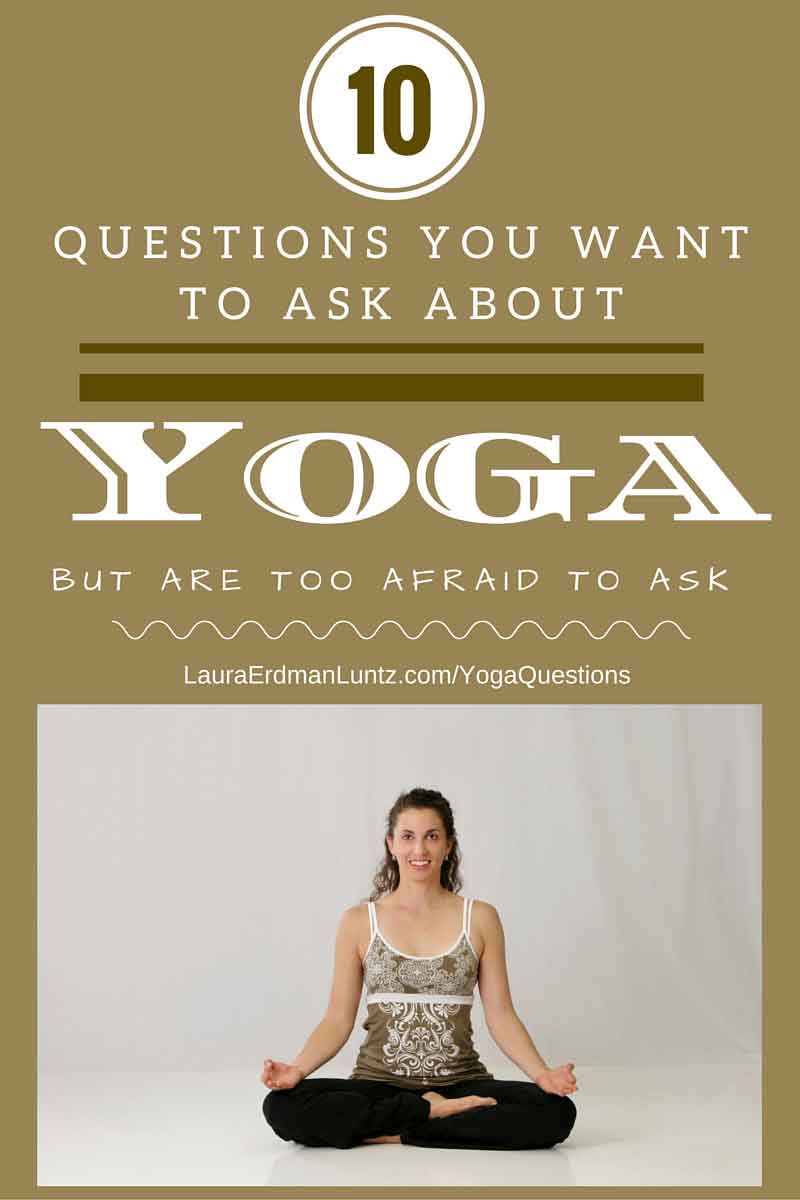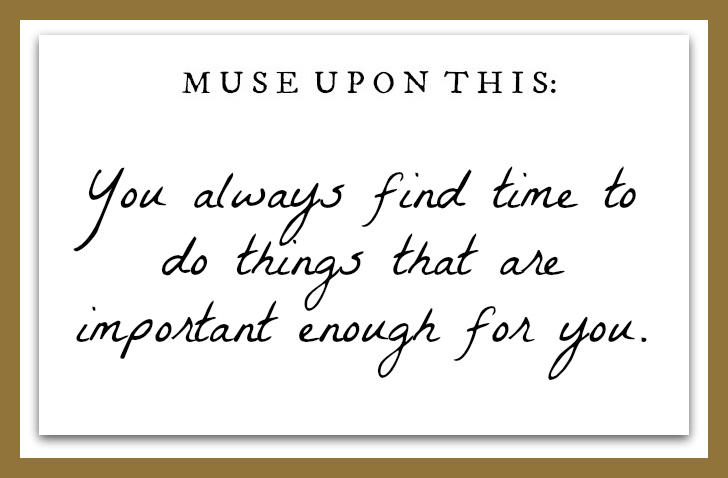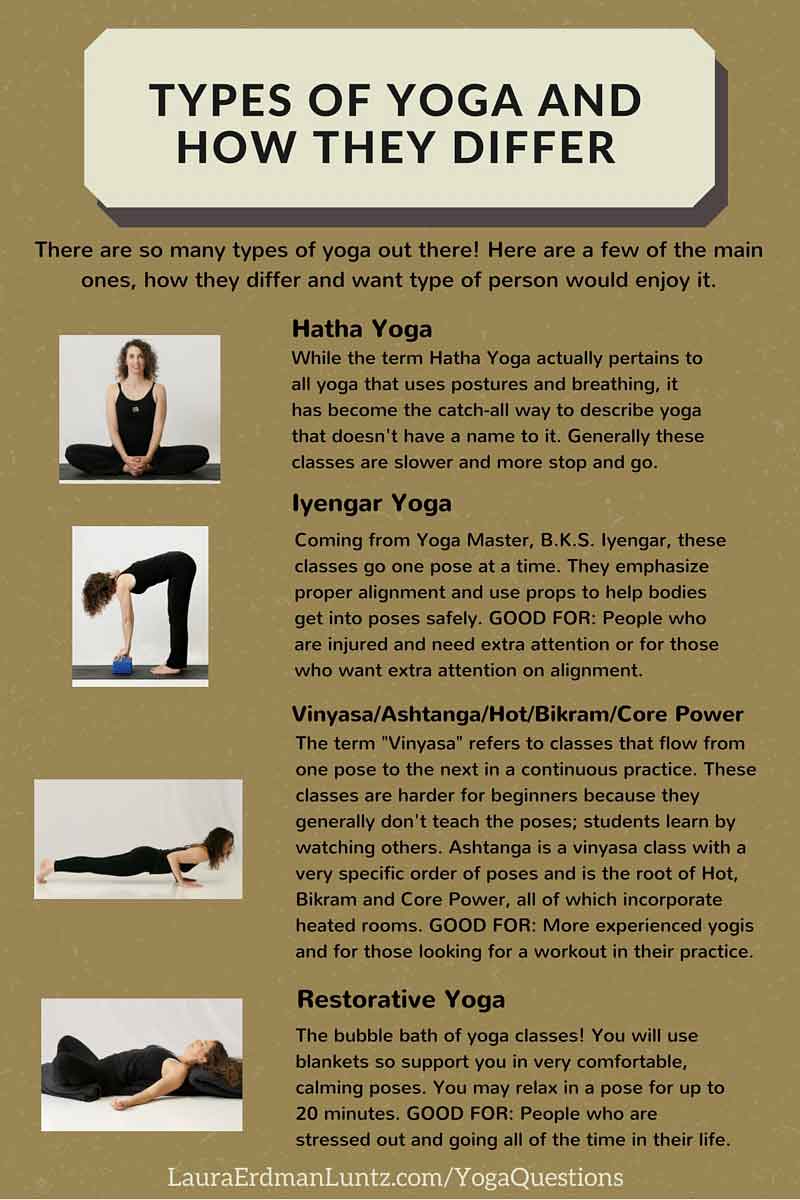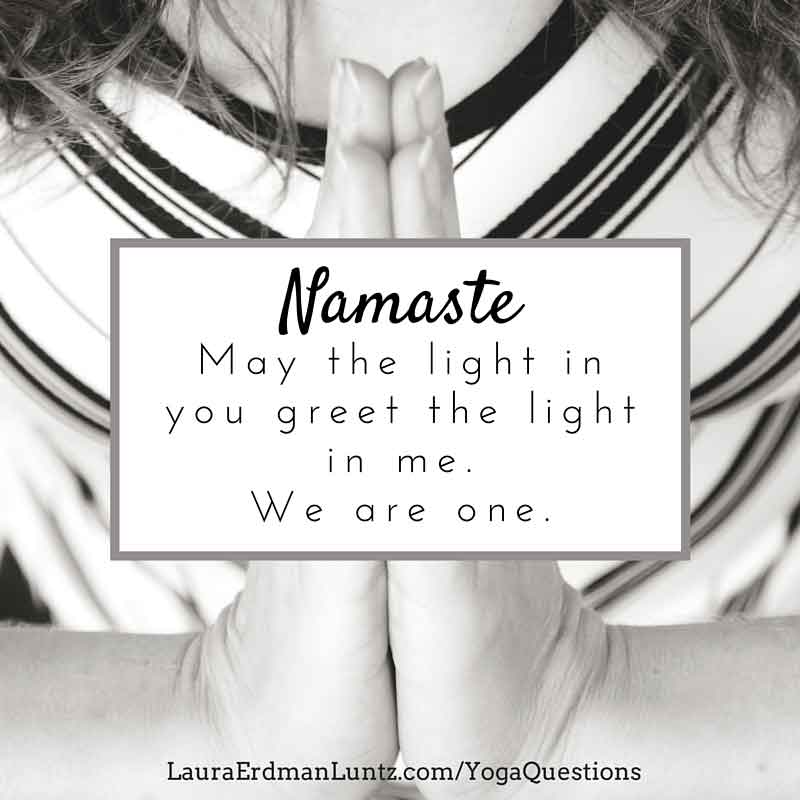
(Note: I am reposting this post from last year in honor of my new release: 5-Day Challenge: Begin Learning Yoga. It is one of my most popular posts of all time. Enjoy!)
Ever had a question, but felt it was too silly to ask? Yeah, me, too. I bet you have one or two about yoga. I am here to say, no question is too big or too small!
Here’s everything you ever wanted to know about yoga, but were afraid to ask.
After teaching yoga for 30+ years, these are the questions I have frequently encountered (or ones I think people are wondering but don’t want to ask).
(Hey, if I miss a question you have, post it in the comments and I’ll add it to the post!)
1. What IS yoga?
Seriously, the best question ever and one people rarely ask!
I would be doing Yoga a huge disservice to think I can describe it in a sound bite, but at the same time I want to share a little something. Just know it’s like describing the Universe – words aren’t enough.
Yoga is essentially a powerful mind-body exercise, which means we encourage you to engage your mind as you move your body. (Don’t laugh. I used to teach aerobics and I remember people saying, “Get me a good workout. I don’t want to think, I just want to leave sweating.”)
That’s not what yoga is about. Yoga is about engaging your mind with your body so you can focus your thoughts and help you begin to declutter both the body and the mind to reconnect with Yourself.
Decluttering your body looks like getting out the kinks and tension so you can relax more deeply. Ever tried to lie in bed and fall asleep with a ton of tension everywhere? Tough, isn’t it? You just can’t relax! But when you start with yoga, it releases that physical tension so you can finally relax and let go.
The same goes with your mind. Our minds are FULL of clutter. Constantly thinking, worrying, judging, even excitement, whether positive or negative, there is just a crazy amount of STUFF in there.
As we focus our attention on the movement, and relax the body, our minds relax, too, allowing us to be present. The quieter we become, the more satisfied with life we are AND the more connected we are with our Higher Mind, that part of us that makes GREAT decisions!
“Yoga is both movement toward and the arrival at the point of deep satisfaction with us that is free from feeling and judgment.”
~ anon
2. Is it a religion?
If I am going to be totally honest here, yes and no. I don’t want this to be a loaded question or have you freak out so read carefully.
When it comes to religion, the exercises of yoga are used within the structure of certain religions such as Hinduism and Jainism. What they use it for is to help them relax so they can focus their minds on prayer and contemplation.
Can’t help but think THAT is a good thing!
Yes, yoga has precepts, but they are truly, truly universal. With ideas such as compassion, honesty, contentment, integrity, kinda hard to argue, I don’t care what religion you are or aren’t.
3. What are the benefits:
So, why bother adding yet another thing to your life? Oh, let me count the ways, my friend!
Yoga is indeed a powerful, powerful tool! Affecting our mind, body, emotions and energy. Sheesh! Talk about one stop shopping!
As a recovering stress-aholic and someone who can have a hard time “finding time”, too, I LOVE when I find something that takes care of so many things at once!
Practicing yoga has been shown to:
- Help you relax and let go of tension.
- Make you happier. A regular practice can increase levels of serotonin, a hormone that helps you feel good.
- Help you focus, teaching you how to be present.
- Protect your spine by keeping muscles supple and strong as well as keeping the discs healthy.
- Regulate the adrenal glands by reducing the levels of cortisol, our stress hormone.
- Improves balance.
- Improves your bone health through weight-bearing exercise.
And this is just a few of the benefits! Yep, worth a few moments out of your day.
4. What do I wear?
I’ll be honest, as a teacher, I do appreciate tight clothing because I can see your alignment better to help you stay safer.
That said, wear whatever you are comfortable in. Really. Just make sure the clothing doesn’t restrict your movement. I would much rather have someone in my class in baggy sweats than not come at all.
I’ve had students show up to class in jeans and even in skirts! They forgot their clothes and decided they wanted their yoga and would do what they could.
Please, please, please, if you have been to a class in baggy clothes and were pointed at or laughed at (yes, I have heard these stories!), find another class. Not all classes are like that, I promise. Find a group of people who honor what you are comfortable wearing.

5. How do I find time to do it?
I get this question all the time. In fact, is is the most common question I receive. To be honest, what I usually hear is something more like, “I would love to do yoga, but I don’t have time.”
Warning: About to get on my soap box and rant a bit.
Start Rant: Seriously, this time thing is getting to be a societal problem. I hear it at a minimum once a day. I am trying to think if I have ever heard someone say, “I have plenty of time. I would love to try something new!” (It almost sounds funny to even say it, doesn’t it?)
Think about this: if something is important enough, you find the time. If someone in the family gets sick, you drop everything to be by their bedside. If you suddenly feel completely disgusted with your weight, you find the time to start a diet or exercise. When your taxes are due, you find the time to get your info together.
Don’t kid yourself.
Make a pact to no longer say, “I don’t have time.” Instead, pause, ask yourself if what you want to do is worth finding the time to do it. If it is, do it. If it isn’t, don’t.
If you keep letting “I don’t have time” into your consciousness, guess what? You will never have time!
If you want to learn yoga, learn yoga. It can be done in such small pockets of time, depending on how you plan to do it. Create the space in your life. You will not regret it.
Okay, end rant.
6. I have a sore shoulder/lower back pain/a bad knee, can I do yoga?
Yes, yes, yes!! BUT you do need to find a qualified teacher who can help you. Not all yoga is the same and not all yoga teachers are the same. (Read below.) You need to find a teacher who is well-educated in physiology and has the time in class to make allowances for you.

7. I’m confused about all of the types of yoga.
I am sure you have noticed, there are tons of types of yoga out there! Vinyasa, hatha yoga, ashtanga, hot, Bikram, Restorative, Sivananda, to name just a few. Holy cow! It is so confusing!
(Let me first counter a common misconception: Hatha Yoga actually refers to almost all of the yoga you see popularized in the United States. Use of the term has become common place when referring to a type of yoga that does not have a name, but really any yoga that incorporates postures and breathing is Hatha Yoga. Kundalini is an example of a yoga lineage that is not hatha.)
Without going into a huge history lesson of yoga, I want you to understand two things. And, honestly, if you take nothing else away from this post, this is crucial:
1. Almost all modern-day yoga descends from one man: Tirumalai Krshnamacharya, a Yoga Master born in India in 1888. He taught the greatest masters of our time:
- Indra Devi: Krishnamacharya’s first female student.
- K. Pattabi Jois: Who became the father of Ashtanga yoga, and the start of all the vinyasa and fitness yoga.
- B.K.S. Iyengar: Who went on to create the props we are so familiar with now and the finely tuned alignment that Iyengar yoga is so famous for.
- T.K.V. Desikachar: Who went on to create Vini-yoga, a one-on-one based yoga that is tailored specifically to the student’s needs.
Why is this important? What this tells us is this one incredible teacher taught his students based on their needs. They all went on to found completely different types of yoga. In other words, each of his students had different needs that then went on to teach a type of yoga that suited THEM.
2. You need to find a type of yoga that fits your personality. Okay, now, stick with me. You need to find a yoga that suits YOU. It must not only fits your personality, but, more importantly, help balance your personality.
This point is where we lost MOST people here in the US. In the US, we tend to lead highly-stressed, busy, frenetic lifestyles. What is the most popular type of yoga by far? Power Yoga.
Power Yoga doesn’t balance this type of personality, it feeds it. It creates MORE stressed out people.
I know, I know, people who do it will swear to me they feel better afterward and I would never argue against that. I am absolutely certain they do. But we need to see beyond yoga as exercise. It is helping us connect to our Higher Selves, not just right after our yoga, but at other times, too.
If we are feeling stressed out all of the time, we need to balance our yoga with a quieter, more restorative one – one of the hardest things to do for a stressed out person! (Believe me, I know. I was, ahem…am, one of them!)
Having said that, if you tend to be a “sit on the couch eating potato chips can’t get yourself motivated or started” kind of person, you are perfect for a more active type of yoga.
I suggest testing out the different types of yoga to see what is right for your personality. Most classes have a first class free policy so you can see for yourself.
8. Two ways to choose your Yoga teacher:
As a former Yoga Teacher Trainer, I will tell you, not all trainings are the same and not all teachers are the same. There are a few too many “fly by night” trainings out there now and they make me nervous.
While it is tempting to simply choose the closest yoga class, you will want to put more thought into your selection.
You need to do your research to keep yourself safe and make sure you are getting the very best yoga experience.
Step One: Start by making sure the teacher has attended at the very minimum of a 200-hour Yoga Teacher training program. As the former creator, director and lecturer of both 200- and 500-hour Yoga Teacher Training programs, 200-hours is the absolute minimum. I always felt like I had barely scratched the surface even after 200 hours.
Step Two: Take a sample class. Many studios will allow you to take your first class for free so you can see if the teacher’s and your personalities mesh. You need to feel good in their presence. If they are disrespectful, don’t answer your questions, or you simply feel uncomfortable in class and you can’t put your finger on it, keep looking! Intuition is a powerful thing. I have heard of way too many people who have been turned off of yoga as a result of a single bad-fit teacher AND I have heard way too many stories of people who stick with teachers who make them feel disrespected.
9. And what is “Sanskrit”? What is “Asana”?
Sanskrit is the ancient language of India. The term “asana” is a Sanskrit word meaning Pose or Seat.
Each yoga pose has a Sanskrit name that reflects the feeling we want to create in the pose, mythological creature with a story behind it, a god, and more. The stories are really quite fun and interesting to learn.
I love to use the Sanskrit name because they are quite poetic when you are teaching. I find the names also reflect the majestry of this art, the history, how it is so much more than exercise.
The “a” is not pronounced at the end of the words. So “asana” is pronounced “a SAN” with an emphasis on the N. Fun, eh?

10. What does “Namaste” mean and can I say it without crossing my religion?
Namaste is a beautiful Sanskrit word that means “may the light in you greet the light in me”. The “light” refers to your soul or Higher Self.
The greeting is used in parts of India as an everyday exchange. What I love most about it is teachers say it to students and students to teachers – with the same level of respect. The greeting is soul to soul and since we all have soul that is equally important, everyone receives the same level of respect. Beautiful.
The second reason I love it is we add the Anjali Mudra to it. A mudra is simply a way of placing the body that directs energy flow through a certain area of the body. The Anjali Mudra, hands placed in front of the heart center, directs energy through the heart. What a lovely way to greet another person’s soul!
11. Bonus: Do I have to be flexible?
No. Next question?
Just kidding. No, of course not. You do yoga to get flexible. It’s like saying you can’t start exercise because you are out of shape.
That said, many yoga classes are filled with really flexible people and the teacher may not accommodate for the 1 or 2 people who aren’t as flexible. You may want to find a class that you feel most comfortable in.